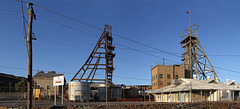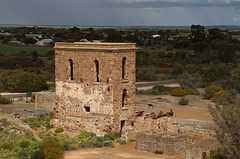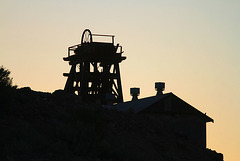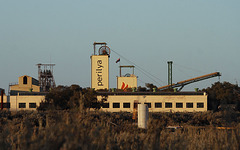
Australia
When rocks go bad!
Rasp Mine
| |
|
|
Production at the Rasp Mine in central Broken Hill has a long and profitable history. Development ceased in 2008 when metal prices fell but as since resumed and the mine currently employs c160 people. Annual production is planned to average 34,000 tonnes of zinc metal in concentrate, 28,000 tonnes of lead metal in concentrate, and 1.1 million ounces of silver in the lead concentrate.
Richmans Enginehouse
| |
|
|
The Moonta mines in South Australia were operating from 1860 until 1923 and produced about 170,000 tons of copper metal. There are still extensive remains of the industry to be seen around the area and this includes a number of enginehouses. This example was completed in 1869 and housed a 32 inch Cornish beam engine driving crushing and concentration machinery. The engine ceased operation in 1917 and was replaced by a gas engine.
Burra terminus
| |
|
|
Disused turntable at the Burra station on the former line from Adelaide. Rail services to Burra discontinued in 1985 and the line closed in 1988, although the rails remain in situ. The grain silos in the background remain in use with road transport.
Silverton
| |
|
|
|
Silver-lead deposits were found in this area in 1875 whilst well drilling and the town of Silverton soon developed as exploitation began. By the 1890s the population was around 3,000 but this soon declined as the best ore became depleted and the Broken Hill deposits began to be developed a short distance away and in 1901 was back to 300 people. These days there are around 50 permanent residents and much of the town has disappeared leaving many relics such as this. It does, however, house a museum dedicated to the film Mad Max 2!
Fuel supplies
Broken Hill
| |
|
|
Five headframes can be seen in part in this view of the south-west end of the lode at Broken Hill. From the left they are:
1. Zinc Mine
2. South Mine No.7 Shaft (1932)
3. North Broken Hill Consolidated Mine haulage shaft
4. North Broken Hill Consolidated Mine service shaft
5. South Mine No.4 Shaft - Oregon Pine headframe (1919)
End of the line
| |
|
|
Beyer Peacock 4-8-2 W934 stands at the end of the running line at Quorn on the Pichi Richi Railway as it prepares to run round the train it has brought from Port Augusta.
Phone bomber
| |
|
The centre of the town of Woomera features a large display of missiles, bombs and planes developed and used on the rocket testing range established from 1947. A night visit yielded a number of views including the public telephone box seen below the tail of a Canberra Bomber. Unless testing is taking place the population of the town is very small. This evening we didn't see a soul.
Thompson Shaft
| |
|
|
The Thompson Shaft at British Mine, Broken Hill, was developed from 1910 as this area took over the main production. Winding from this shaft appears to have ended in 1958.
Menindee
| |
|
|
Disused railway water tanks stand forlorn at Menindee on the line between Sydney and nearby Broken Hill. They are all Braithwaite products.
On the tracks of the Ghan
| |
|
GWU 003 and ALF 19 head south at Woocalla towards Port Augusta with single and double-stack containers. We had stopped by the line for a rest on our way to Woomera and had hoped for a train to appear. Needless to say it was only after we set off again that this one appeared in the opposite direction. A long chase followed until we were able to overhaul it and dash onto a small mound for a grab shot against the setting sun.
North Broken Hill Consolidated Mine
| |
|
Perilya operates the NBHC Mine, although it is now controlled by Chinese metal company Shenzhen Zhongjin Lingnan Nonfemet Co., Ltd. The shaft on the left isover Main Shaft at Zinc Mine where operation ceased in 1988. The central headframe is the skip winding shaft which was refurbished in 1988 and has a capacity of 2.9 million tonnes per year. The right headgear is for the service shaft with cages.
Riding the Indian Pacific
| |
|
A look at the locomotives from the lounge car on the Indian Pacific as it approaches Broken Hill.
Heading for Quorn
| |
|
|
|
Beyer Peacock 4-8-2 W934 heads the morning service from Port Augusta above Woolshed Flat on the Pichi Richi Railway. The line is well suited to car chasing for most of the way to Quorn although a lot of the locals seemed to want to stand right next to the track photographing rivets and buffers!
Parked in the bush
Iron Baron
| |
|
|
Iron Baron (7950 tons dwt) was built in 1936 by Lithgows at Port Glasgow as an Ore Carrier for Broken Hill Proprietary Ltd. The first ship of the 'Chieftain' class she worked between Whyalla and Newcastle carrying ironstone until sold in 1966. The ship is seen here unloading at Steel Works Wharf, Newcastle in 1936. Destination for the ore, a blast furnace with associated Cowpar stoves are visible on the right.
Elrington Colliery
| |
|
No.2 shaft top Broken Hill Proprietary Co. Ltd, Elrington Colliery, New South Wales, 1936. Coal production started here in 1930 using two concrete lined shafts each 18ft in diameter down to the top Greta seam at 1200ft. Elrington Colliery was served by Hebburn Limited private railway. A spur branch track diverted from this railway just prior to the entry to Hebburn No. 2 Colliery. The pit-top screens at the Colliery were 14 miles 12 chains distant by rail from the NSW Government Railways at East Greta Junction. The colliery closed in December 1962 although large reserves of coal remain untouched.
Lots more details available here .
Jump to top
RSS feed- Latest items - Subscribe to the latest items added to this album
- ipernity © 2007-2024
- Help & Contact
|
Club news
|
About ipernity
|
History |
ipernity Club & Prices |
Guide of good conduct
Donate | Group guidelines | Privacy policy | Terms of use | Statutes | In memoria -
Facebook
Twitter


















